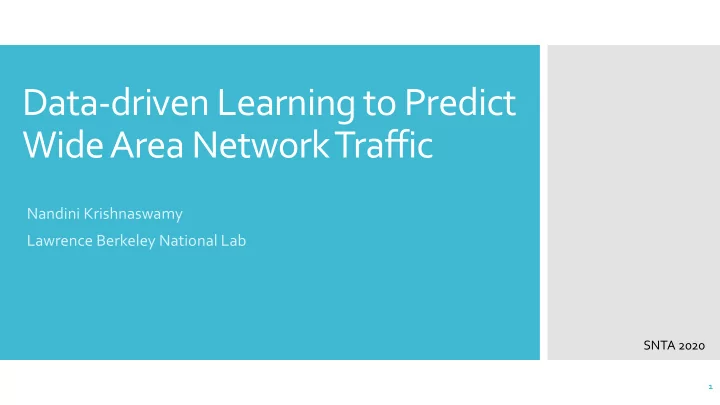

Data-driven Learning to Predict Wide Area Network Traffic Nandini Krishnaswamy Lawrence Berkeley National Lab SNTA 2020 1
62% Year- on-Year Growth Log scale 103 PB – Mar ‘19 Network Traffic Growth This diagram illustrates the growth rate of traffic on ESnet backbone (The Department of Energy’s dedicated science network). Projected 62% growth every year. 2
Year 2019 Bandwidth Usage Normalized shows only up to 40% used DOE Networks Link Utilization Links are designed to be used at 40% capacity for unanticipated traffic surges. How can we improve utilization? Proposed solution: Predict future network traffic. 3
Challenges posed by Traffic Prediction Noisy data Missing data Multiple hour forecasts 4
SNMP data collected at router interfaces Traffic volume in GBs 30 second intervals (aggregated to 1 hour intervals) 1 year in total 4 Bidirectional links (8 traces) ESnetTrans-Atlantic links Traffic Data Used 5
Fourier analysis Correlation heat map file:///Users/nandinik/Desktop/2018-Jan-Dec(1).gif Justification of Chosen Links 6
ARIMA Autoregressive Integrated Moving Average Requires stationary series as input (can make series Classical stationary through differencing) Holt-Winters Time Series Triple exponential smoothing Algorithms Smoothing equations correspond to: Level Trend Seasonality 7
Traditional Recurrent Neural Networks (RNNs) Feedback loop -> during training, RNN will unfold into deep feedforward network Vanishing gradient problem -> cannot capture long-term dependencies 8
Long Short- Term Memory (LSTM ) Network Variant of RNN Memory to track long time period Can learn long-term dependencies 9
Stacked LSTM (two LSTM Simple LSTM (one LSTM layers) Three LSTM layer) Variants Seq2Seq LSTM 10
ARIMA: Inspect AC and PAC plots Holt-Winters Model Trial-and-error/grid search Parameters LSTM Tested different # of nodes in hidden layers Tested different activation functions 11
Performance Comparison • Af-Lnd has strong seasonality • Wash-Cern problematic data collection • All LSTM approaches are better • Each link has different behavior 12
Deploy prediction tools to inform network engineering. Conclusion Further research: Extend prediction periods Experiment with different NN architectures 13
Email me at nk2869@columbia.edu with Thank you! any questions! 14
Recommend
More recommend